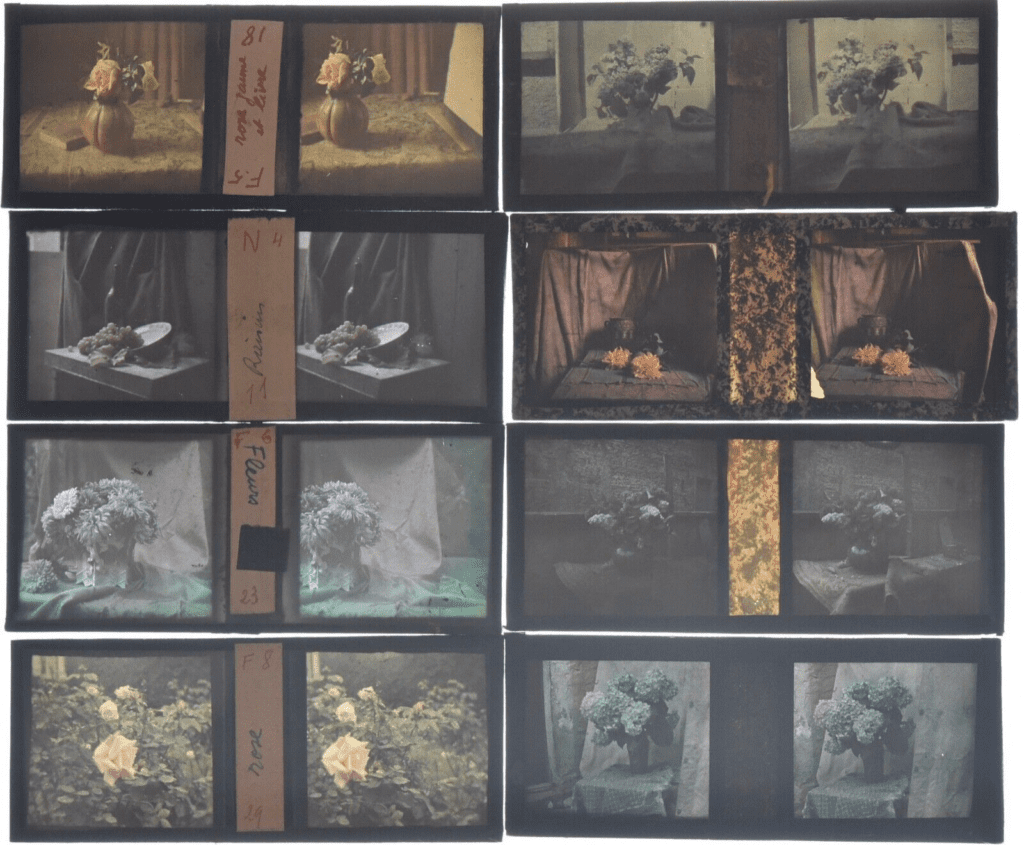Lumiflavin is a toxic product of photolysis of vitamin B2.
- Rodríguez-Otero, Jesús; Martínez-Núñez, Emilio; Peña-Gallego, Angeles; Vázquez, Saulo A (2002). “The Role of Aromaticity in the Planarity of Lumiflavin”. The Journal of Organic Chemistry. 67 (18): 6347–6352. doi:10.1021/jo011159c. PMID 12201752.
Lumiflavin is a compound showing yellow-green fluorescence, formed by a photolysis of riboflavin in alkaline solution.
- National Center for Biotechnology Information. PubChem Compound Summary for CID 66184, Lumiflavin. https://pubchem.ncbi.nlm.nih.gov/compound/Lumiflavin. Accessed Aug. 3, 2023.
Lumiflavin 1948-Present
Lumichrome 1944-Present

The Autochrome Lumière was an early color photography process patented in 1903 by the Lumière brothers in France and first marketed in 1907. Autochrome was an additive color “mosaic screen plate” process. It was the principal color photography process in use before the advent of subtractive colorfilm in the mid-1930s.
- French patent 339,223, Dec. 17, 1903. Journal of the Society of Chemical Industry, 1905.
- Chisholm, Hugh, ed. (1911). “Photography” . Encyclopædia Britannica. Vol. 21 (11th ed.). Cambridge University Press. p. 518.
- “Color Theory-Autochrome”. Home.bway.net. 1906-06-05. Retrieved 2013-01-29.
Autochrome is an additive color “mosaic screen plate” process. The medium consists of a glass plate coated on one side with a random mosaic of microscopic grains of potato starch dyed red-orange, green, and blue-violet (an unusual but functional variant of the standard red, green, and blue additive colors); the grains of starch act as color filters. Lampblack fills the spaces between grains, and a black-and-white panchromatic silver halide emulsion is coated on top of the filter layer.[citation needed]
- “Color Theory-Autochrome”. Home.bway.net. 1906-06-05. Retrieved 2013-01-29.
- “Collections | National Museum of American History”. Americanhistory.si.edu. 7 February 2012. Retrieved 2013-01-29.
Unlike ordinary black-and-white plates, the Autochrome was loaded into the camera with the bare glass side facing the lens so that the light passed through the mosaic filter layer before reaching the emulsion. The use of an additional special orange-yellow filter in the camera was required to block ultraviolet light and restrain the effects of violet and blue light, parts of the spectrum to which the emulsion was overly sensitive. Because of the light loss due to all the filtering, Autochrome plates required much longer exposures than black-and-white plates and films, which meant that a tripod or other stand had to be used and that it was not practical to photograph moving subjects.
- M. L. Heidingsfeld (June 27, 1908). “The New Lumiere Process of Color Photography”. The Lancet-Clinic. Lancet-Clinic Pub. Co. LXXXXIX (26).
The plate was reversal-processed into a positive transparency — that is, the plate was first developed into a negative image but not “fixed”, then the silver forming the negative image was chemically removed, then the remaining silver halide was exposed to light and developed, producing a positive image.[citation needed]
The luminance filter (silver halide layer) and the mosaic chrominance filter (the colored potato starch grain layer) remained precisely aligned and were distributed together, so that light was filtered in situ. Each starch grain remained in alignment with the corresponding microscopic area of silver halide emulsion coated over it. When the finished image was viewed by transmitted light, each bit of the silver image acted as a micro-filter, allowing more or less light to pass through the corresponding colored starch grain, recreating the original proportions of the three colors. At normal viewing distances, the light coming through the individual grains blended together in the eye, reconstructing the color of the light photographed through the filter grains.[citation needed]

Leave a Reply